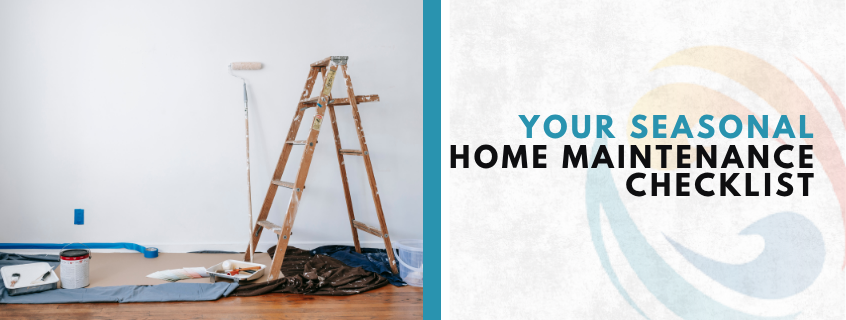
Every home has a rhythm, changing slightly with the seasons. While you may not always notice it, your house quietly weathers the effects of wind, rain, heat, and cold. And just like we rotate our wardrobes for the weather, your home also needs a little seasonal attention. That’s why having a trusted seasonal home maintenance checklist isn’t just smart—it’s necessary to keep surprises and costly disasters at bay.
So whether you’re sipping iced lemonade in summer or unpacking winter sweaters, there’s always something simple (yet important) you can do to protect your home. Below is your all-in-one seasonal home maintenance checklist, packed with easy, doable tips that can save you from future headaches and major repairs.
Check and Clean Gutters Regularly
Gutters are the unsung heroes of your home. They quietly guide rainwater away from your walls, windows, and foundation. But when they get clogged with leaves or debris, they turn from helper to hazard. Rain starts to overflow, soaking your siding or pooling around your foundation, which can lead to water damage.
Here’s what to do:
- Scoop out leaves, twigs, and gunk every spring and fall.
- Use a hose to check for good water flow.
- Watch for leaks, cracks, or sagging sections.
- If water pools near your home, adjust downspouts so water runs at least 5 feet away.
Incorporating this into your seasonal home maintenance checklist helps protect your foundation and keeps water damage at bay. Not doing so? That’s one of the fastest ways to end up searching for emergency water cleanup services sooner than you’d like.
Inspect and Seal Doors and Windows
Think of doors and windows like your home’s lungs—they let in air and light. But if they’re not properly sealed, they also let in drafts, bugs, and moisture. Over time, this leads to high energy bills and interior damage.
Keep these steps in mind:
- Check seals and weatherstripping.
- Feel for air leaks on windy days.
- Replace cracked caulking around window frames.
- Install door sweeps if needed.
Updating door and window seals should be part of your seasonal home maintenance checklist during spring and fall, especially before temperature swings. It helps your HVAC system work less while keeping your home cozy and efficient.
Service Your HVAC System
No one wants to sweat through summer or freeze during winter due to a faulty HVAC unit. Routine maintenance keeps your system running efficiently and avoids costly replacements.
Make sure to:
- Replace or clean air filters every 1–3 months.
- Get a professional checkup once before summer and once before winter.
- Vacuum out air vents and registers.
- Clear outdoor units of leaves and debris.
This seasonal home maintenance checklist step ensures you’re never caught off-guard by a broken heater or AC unit when you need it most.
Bonus Tip: A well-maintained HVAC system also helps reduce indoor humidity, lowering your chances of mold issues. Speaking of that…
Check for Mold-Prone Areas
Mold is sneaky. It hides in dark, damp spots and can cause major health and structural problems before you even notice it’s there.
Places to inspect:
- Under sinks
- In basements and crawl spaces
- Around windows with condensation
- Near appliances like water heaters and washers
Use this part of your seasonal home maintenance checklist to look for musty smells, bubbling paint, or dark patches on walls. Catching mold early saves money and protects your health.
Inspect the Roof for Loose or Damaged Shingles
Roof problems often go unnoticed—until they lead to water damage inside your house. Rainwater sneaks in, damaging ceilings, walls, and insulation. That’s why seasonal roof checks are critical.
What to look for:
- Cracked, curled, or missing shingles
- Signs of moss or algae
- Rusted or damaged flashing around vents or chimneys
- Interior ceiling stains
This seasonal home maintenance checklist tip is especially important after storms or heavy snow. One missing shingle could spell disaster.
Did you know? Homes near coastal areas like Playa Del Rey often face roof and water damage due to salty air and wind erosion. Residents should perform this check more frequently.
Test Smoke and Carbon Monoxide Detectors
These little devices can save lives. But only if they work. Batteries can die without warning, and detectors themselves wear out over time.
Maintenance checklist:
- Press the “test” button once a month.
- Replace batteries every 6 months.
- Clean with a vacuum to remove dust.
- Replace devices every 7–10 years (check the label).
Including detector checks in your seasonal home maintenance checklist helps keep your family safe year-round.
Flush the Water Heater
Over time, sediment builds up in your water heater. This makes it work harder and shortens its lifespan. Flushing the tank removes this buildup, saving money and improving performance.
Do this:
- Turn off the power or gas supply.
- Let the tank cool slightly.
- Connect a hose to the drain valve.
- Let the water drain into a bucket or outside.
- Close the valve and refill.
Adding this to your seasonal home maintenance checklist helps your heater last longer and keeps energy costs lower.
Clean and Inspect the Dryer Vent
Lint isn’t just annoying—it’s a serious fire hazard when it builds up in your dryer vent. According to fire safety stats, it’s one of the top causes of house fires.
Steps to take:
- Clean the lint trap after every load.
- Detach the dryer vent hose twice a year and vacuum it out.
- Look for blockages in the outdoor vent cover.
Use your seasonal home maintenance checklist to schedule these cleanouts every spring and fall. It only takes 15 minutes, but it can save your entire home.
Trim Trees and Shrubs Near Your Home
Trees provide shade, beauty, and privacy, but when left unmanaged, they can also cause major issues. Overhanging branches may break and fall on your roof, scratch siding, or clog gutters with leaves.
Tips:
- Cut back branches that hang over your roof or driveway.
- Clear away shrubs close to windows and vents.
- Watch for dead or diseased trees and remove them.
Your seasonal home maintenance checklist should include landscaping updates at least twice a year—early spring and mid-fall are best.
Check for Foundation Cracks and Drainage Problems
Water is powerful. Over time, poor drainage or minor foundation cracks can lead to major structural problems. And once water gets inside? It brings mold, bugs, and hefty repair bills.
Here’s what you should do:
- Walk around your home after rain to spot puddles or soggy areas.
- Look for cracks inside the basement or exterior foundation.
- Seal small cracks with caulk or epoxy.
- Regrade the oil or add extensions to downspouts to direct water away.
This seasonal home maintenance checklist step is especially critical for older homes or those in flood-prone areas. And if you ever spot water pooling indoors, don’t wait—get professional restoration support immediately.
Seasonal Home Maintenance Checklist Summary Table
| Task | Season | Why It Matters | Frequency |
| Clean gutters | Spring/Fall | Prevents water damage and foundation erosion | 2x a year |
| Seal windows/doors | Spring/Fall | Boosts energy savings and keeps out pests | 2x a year |
| HVAC maintenance | Spring/Fall | Avoids breakdowns and improves air quality | 2x a year |
| Roof inspection | Spring/Fall | Catches leaks early before they cause inside damage | 2x a year |
| Water heater flush | Spring | Extends unit life and saves on energy costs | 1x a year |
| Dryer vent cleaning | Spring/Fall | Reduces risk of fire | 2x a year |
| Mold checks | Spring/Fall | Protects your health and home structure | 2x a year |
| Foundation check | Fall | Avoids water seepage and structural shifting | 1–2x a year |
| Tree trimming | Spring/Fall | Prevents roof and siding damage | 2x a year |
| Smoke detector test | Year-round | Ensures family safety from fire and carbon monoxide | Monthly/battery 2x a year |
Why the Seasonal Home Maintenance Checklist Matters
A well-followed seasonal home maintenance checklist saves you from unexpected repair bills and gives peace of mind. Homes that get checked regularly simply last longer and cost less to maintain. Here’s a quick breakdown to keep in mind:
A = Always Check
B = Be Proactive
C = Call Professionals When Needed
D = Don’t Delay Repairs
By sticking to a consistent schedule, you don’t just protect your house—you create a more comfortable, healthier, and safer home for everyone inside.
Final Thoughts
Taking care of your home doesn’t have to be complicated. With a reliable seasonal home maintenance checklist in hand, you’re already ten steps ahead. Each season brings different weather challenges, but with small actions, you can avoid big problems.
And remember, if you ever spot water damage or leaks that are out of your hands, it’s best to act fast. Whether you live inland or near coastal areas like Playa Del Rey that often face flooding issues, it’s better to solve it now than wait for bigger trouble.
Start with the checklist today. Your future self—and your house—will thank you later.
Frequently Asked Questions: Seasonal Home Maintenance Checklist Made Simple
Why do I need a seasonal home maintenance checklist?
A seasonal home maintenance checklist helps you prevent costly repairs by catching small issues early. It ensures your home stays safe, efficient, and in good shape all year round.
When is the best time to start home maintenance tasks?
The best times are early spring and fall, when weather shifts require extra care for heating, cooling, and water systems. These seasons allow you to prepare for harsher conditions ahead.
How do I know if my roof or gutters need attention?
Look for visible signs like missing shingles, sagging gutters, or water stains on ceilings. Overflowing gutters or pooling water around your home also indicate trouble.
What’s the risk of skipping tasks like HVAC checks or mold inspection?
Skipping these can lead to poor air quality, expensive breakdowns, or hidden mold growth. Regular checks keep your home healthy and systems running smoothly.
Can I handle all these tasks myself, or should I hire professionals?
You can do many tasks yourself, like cleaning gutters or changing filters, with basic tools and time. But for issues like leaks, mold, or water damage, professional help is highly recommended.






